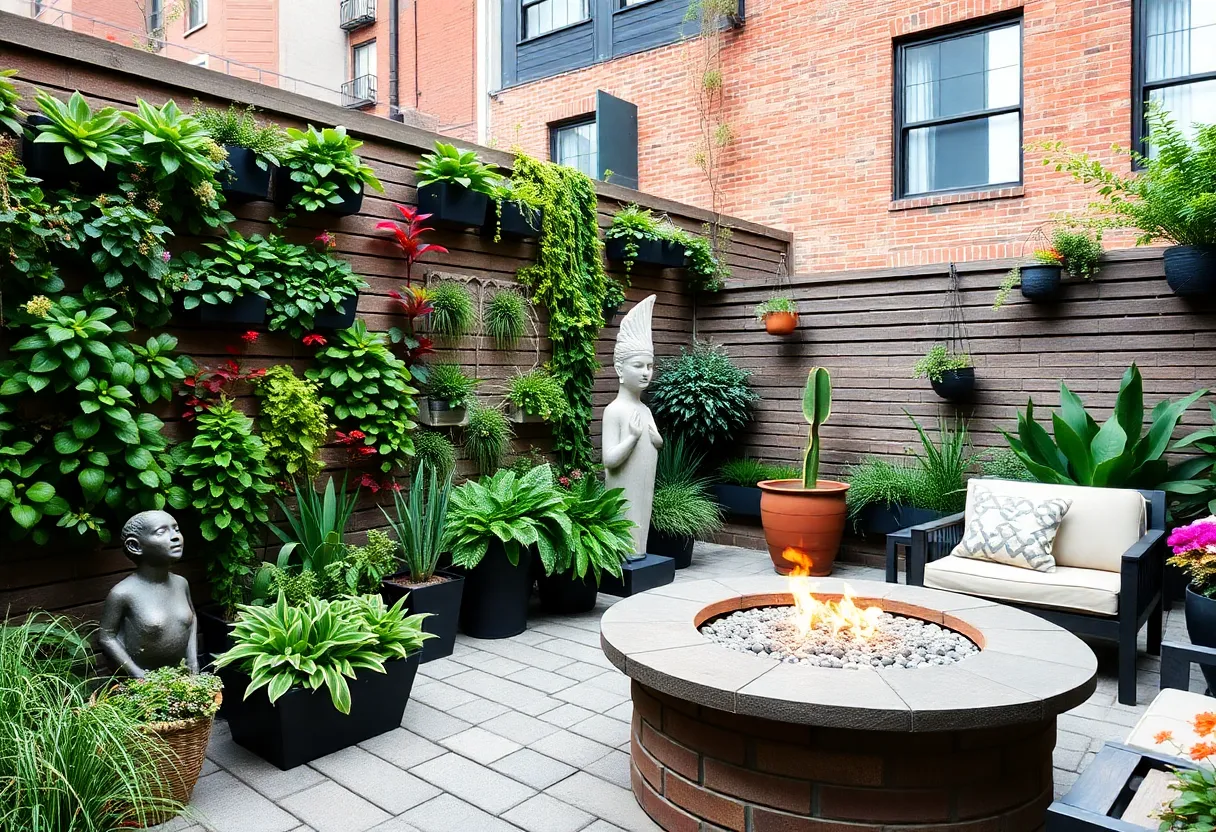Transforming a Compact New York Garden into a Vibrant, Productive Space
Transforming a small New York garden into a lively, productive environment is entirely achievable through strategic planning and thoughtful design. Despite limited space, careful implementation of specific techniques can maximize your garden’s potential, providing a lush retreat, abundant harvest, and visual delight. This guide highlights essential methods to optimize every inch of your compact garden, ensuring a functional and aesthetically pleasing outdoor space.
Assess Your Space and Define Goals
Evaluate Dimensions, Sunlight, and Soil
The initial step involves thoroughly assessing your garden’s size, noting its precise measurements. Determine sunlight exposure—identify areas receiving full sun, partial shade, or shade throughout the day. Soil quality is equally vital; test your soil to understand its composition, drainage capacity, and nutrient status. These factors influence plant selection and placement.
Establish Clear Gardening Objectives
Precise goals are fundamental to an effective design. Ask whether your intent is to grow vegetables, cultivate ornamental plants, create a peaceful retreat, or combine these objectives. Clear priorities inform the layout and plant choices, enabling you to tailor your efforts for maximum satisfaction.
Maximize Vertical Space with Innovative Techniques
Implement Vertical Gardening
Vertical gardening is a cornerstone strategy in small spaces. Use trellises, wall-mounted planters, and hanging baskets to grow climbing plants such as tomatoes, cucumbers, beans, or decorative vines. These structures conserve ground space while adding layers of visual interest. Ensure support structures are sturdy and capable of bearing mature plant weight.
Utilize Wall Space Creatively
Walls and fences are prime real estate. Installing vertical gardens or pocket planters can turn blank surfaces into lush, green displays. Such arrangements reduce clutter on the ground and make the garden feel more expansive.
Adopt Raised Beds and Container Gardening
Benefits of Raised Beds
Raised beds provide excellent control over soil conditions, ideal for urban environments where soil may be contaminated or poorly drained. They improve drainage, soil warmth, and accessibility, making gardening easier and more productive.
Advantages of Containers
Container gardening offers flexibility and mobility. Select containers based on plant needs and the available sunlight. Move them to optimize exposure or protect plants from harsh weather. Use self-watering containers to reduce maintenance and ensure consistent moisture supply.
Choose Compact and Dwarf Varieties
Utilize Dwarf and Compact Plants
Opt for dwarf or compact plant varieties tailored for small spaces. Modern breeding has produced smaller-sized vegetables, fruits, and ornamental plants that deliver full flavor and bloom potential without sprawling or overcrowding. This approach allows cultivation of diverse species while maintaining a manageable scale.
Examples of Suitable Varieties
Examples include dwarf tomatoes, strawberries, miniature roses, and compact herbs, all of which thrive in limited areas. When selecting plants, check for growth habits, mature size, and light requirements to optimize your layout.
Implement Layered Planting for Depth and Efficiency
Create Visual and Spatial Layers
Layered planting involves arranging plants of varying heights and habits to maximize space and enhance visual depth. Position taller plants at the back or center, with medium-height and shorter plants toward the front or edges.
Improve Light Penetration and Access
This method ensures that all plants receive adequate sunlight and that maintenance tasks remain accessible. Layering also creates a natural sense of enclosure and diversity, elevating the garden’s aesthetic appeal.
Practice Companion Planting to Enhance Growth and Pest Control
Maximize Space and Support Plant Health
Companion planting involves pairing plants with mutually beneficial relationships. Such combinations can improve flavor, deter pests, and optimize nutrient uptake.
Effective Pairings for Small Gardens
Examples include planting basil alongside tomatoes to enhance flavor and repel pests, or marigolds with vegetable crops to ward off nematodes. Incorporate nitrogen-fixing plants like beans next to heavy feeders for balanced soil fertility.
Train Fruit Trees Using Espalier Techniques
Space-Saving Fruit Production
Espalier involves training fruit trees to grow flat against a wall or fence. This approach is ideal for small spaces since it maximizes fruit yield without taking up significant ground area.
Implementation Tips
Requires regular pruning, support structures, and patience. Suitable for apple, pear, and cherry trees, espalier creates a productive, attractive feature while preserving space. Proper training enhances air circulation and disease management.
Add Water Features to Enhance Aesthetics and Biodiversity
Small-Scale Water Features
Incorporating a small fountain, pond, or birdbath can significantly elevate the garden’s visual and sensory appeal. These features attract wildlife, provide calming sounds, and serve as focal points.
Design Considerations
Choose size and style compatible with your space. Use pools with minimal barriers for ease of maintenance. Ensure the water feature integrates seamlessly with the overall layout, complementing plantings and pathways.
Optimize Watering with Efficient Irrigation
Reduce Waste and Ensure Consistent Moisture
Effective watering is critical, especially in small, densely planted gardens. Implement drip irrigation systems or self-watering containers to deliver water directly to roots, minimizing evaporation and runoff.
Automation and Scheduling
Automate watering schedules to maintain consistent soil moisture, preventing stress and disease. Regularly check and adjust systems for effectiveness and efficiency.
Choose Materials and Furniture with Space-Saving Design
Functional and Compact Elements
Select foldable, stackable, or multi-use furniture to maximize usable space. Opt for lightweight, durable materials suitable for local weather conditions.
Minimize Visual Clutter
Use cohesive materials and neutral tones that blend into the environment, making the space feel larger and more inviting. Incorporate storage solutions to keep tools and supplies organized and out of sight.
Plan for Seasonal Dynamics and Continuous Harvests
Design for Year-Round Interest
Integrate a mix of perennials, annuals, and biennials to provide seasonal color, texture, and interest throughout the year. Consider succession planting to fill gaps and ensure continuous productivity.
Adaptability and Flexibility
Use moveable containers and modular arrangements to adapt to changing seasons and weather conditions. Regularly refresh plantings to maintain vibrancy and vitality.
Consistent Maintenance for Long-Term Success
Establish a Routine
Regular watering, pruning, weeding, and pest management are cornerstones of a healthy garden. Scheduled maintenance prevents overgrowth, disease, and pests.
Monitoring and Adjusting
Keep an eye on plant health and soil conditions. Adapt care routines as necessary to optimize growth and productivity over time.
Conclusion
By applying these strategic techniques, you can transform a compact New York garden into a vibrant, productive oasis. Thoughtful space management, plant selection, and layout design enable maximum usage of limited square footage. A balanced combination of vertical gardening, container cultivation, layered plantings, and creative features will create a space that reflects personal style, encourages productivity, and offers year-round enjoyment. Thoughtful planning and diligent maintenance are essential to turn any small garden into a flourishing retreat that delights both the senses and the senses of sustainability.
Author: STAFF HERE NEW YORK WRITER
The NEW YORK STAFF WRITER represents the experienced team at HERENewYork.com, your go-to source for actionable local news and information in New York, the five boroughs, and beyond. Specializing in "news you can use," we cover essential topics like product reviews for personal and business needs, local business directories, politics, real estate trends, neighborhood insights, and state news affecting the area—with deep expertise drawn from years of dedicated reporting and strong community input, including local press releases and business updates. We deliver top reporting on high-value events such as New York Fashion Week, Macy's Thanksgiving Day Parade, and Tribeca Film Festival. Our coverage extends to key organizations like the Greater New York Chamber of Commerce and United Way of New York, plus leading businesses in finance and media that power the local economy such as JPMorgan Chase, Goldman Sachs, and Bloomberg. As part of the broader HERE network, including HEREBuffalo.com, we provide comprehensive, credible insights into New York's dynamic landscape.





